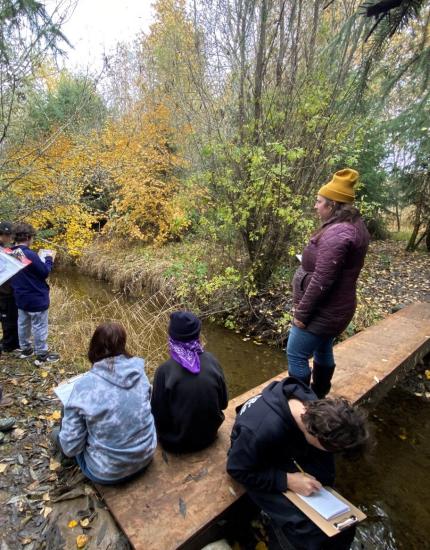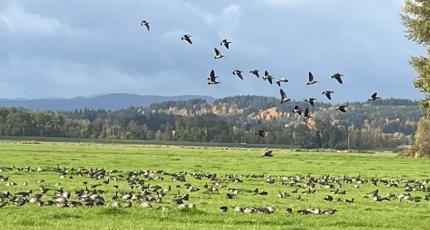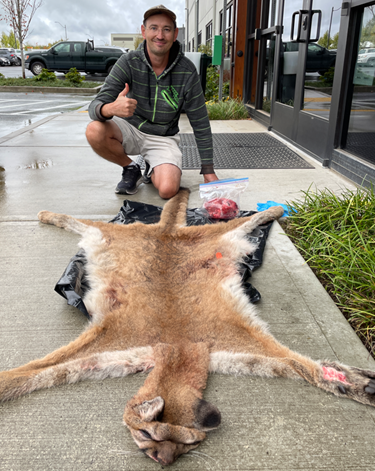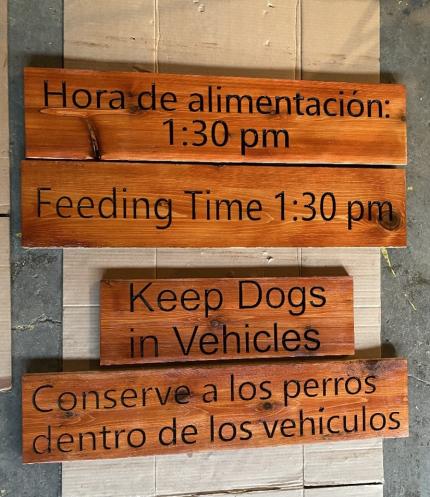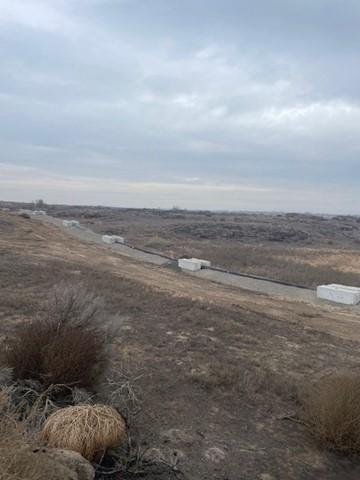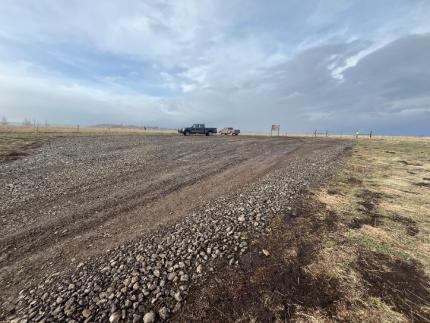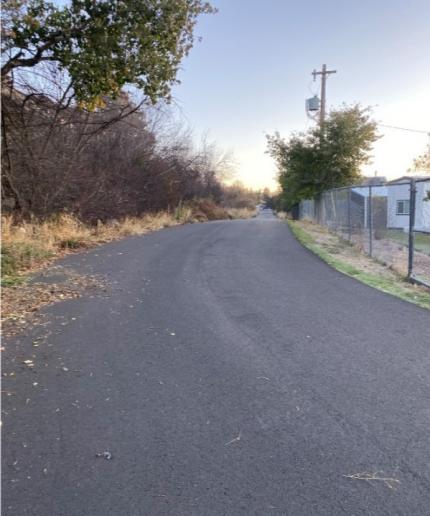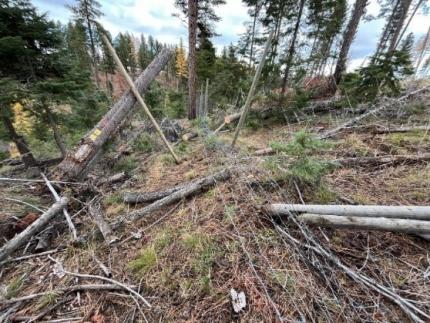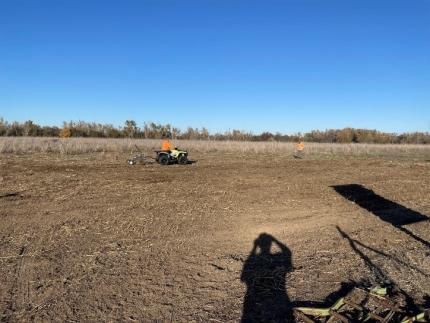Biweekly report Nov1-15 2024 - Region 5 (Southwest)
Managing Wildlife Populations
Western Gray Squirrel Surveys in Lewis County: Biologists Stephens and Holman conducted a third round of efforts in response to the presence of a dead western gray squirrel on U.S. Forest Service managed lands in eastern Lewis County two years ago. The effort finally paid dividends, producing multiple videos and still photographs of western gray squirrels alive and well near the location of the dead individual. Thanks to Species Lead Kohler, Region 6 Wildlife Diversity Biologist Sage, and Growth Management Biologist Salter for their assistance on the project.
Hunter Harvested Wildlife Checks: Regional wildlife biologists, wildlife conflict specialists, and customer service specialists continue to check hunter harvested wildlife. Many species of wildlife including cougars, bobcats, bears, big-horned sheep, and mountain goats have various checking requirements to facilitate biological sample collection and assure the legality of harvests. Hunters are reminded to check the Big Game Seasons Pamphlet to be clear on checking requirements for various species. Recently, Biologist Holman checked a mountain goat, a cougar, and evaluated several sets of elk hooves in association with the hoof disease incentive program. Congratulations to the successful hunters.
Northwestern Pond Turtle Habitat Use Study Presentation: Biologists Ott and Bergh, along with Ph.D. student Chen from the University of Washington, participated in Webinar Wednesdays, a series hosted by Washington State Department of Transportation (WSDOT) Research and Library Services. During their presentation, they provided an overview of an ongoing collaborative study involving WSDOT, the University of Washington, and Washington Department of Fish and Wildlife (WDFW). The study focuses on assessing the movements and habitat preferences of the state-endangered northwestern pond turtle. This research was funded in part by WSDOT Quick Response funds and the WDFW Biodiversity Grant Program. The final analyses and findings of this study are expected to be completed in Spring 2025.
Klickitat Mule Deer Mortality: Biologist Wickhem responded to a mortality notification from one of the district’s mule deer radio-collars this week. The collars send an email via satellite when an animal has not moved for at least nine hours. When Wickhem arrived at the location, the deer, a doe, was completely intact, with blood and rumen seeping out of its nose and blood coming out of its ears. The doe was only approximately 100 feet from a paved road and appeared to have been hit by a car. This deer is part of a four-year study being conducted throughout GMUs 388 and 382 to track the annual movements of female mule deer and locate important migration corridors. Staff members are also attempting to determine cause of death when an animal dies, which has proven to be difficult. In winter 2021, 81 collars were deployed throughout GMUs for this effort. Twenty-two collars were deployed in the winter of 2022 and 23 collars in winter 2023 - most of which were redeployments replacing study deer that died over the first two years of the study. We are nearing the end of the study so these collars will not be redeployed for this project.
Providing Recreation Opportunities
Deer Season on the Klickitat Wildlife Area: The 2024 deer season on the Klickitat Wildlife Area marked a successful period for hunters, with a notable increase in recreation and visitation due to a management shift on the Simcoe Unit. For the first time, this unit was open for general season hunting, a change from previous years' special draw requirements. This adjustment provided additional opportunities for harvesting mule deer on both the Simcoe and Soda Springs units, attracting a significant number of hunters to the area.
Although the season ran smoothly overall, a few incidents highlighted the importance of fire awareness and readiness, as well as abiding by current fire bans and restrictions. These included an engine fire that was promptly managed without spread and a campfire incident on the western side of the property. Gusting 15 mph winds led the campfire to spread across approximately two to five acres before it was successfully contained.
Modern Firearm Deer Season Opener: Biologists Wickhem and Ott teamed up with WDFW Enforcement Officers Nelson and Way to patrol the district for the opening day of modern firearm deer season. Ott and Way worked both black-tail and mule deer territory. Wickhem and Nelson focused solely on mule deer and worked on or near the Simcoe Mountains Unit of the Klickitat Wildlife Area most of the day. The teams talked with and checked numerous hunters but unfortunately did not check any harvested deer. Wickhem and Nelson did check two harvested black bears and saw another bear while working on Simcoe.
Down Trees: With the coming stormy weather, windthrown and rotten trees are going to become more common. In some cases, the trees do not impede access to specific sites. Recently, however, a large snag fell across the road at the north Liedl Access Area, making it necessary to buck up the log enough to make room for passing traffic. Fortunately, there was a way around the log, but it was at a sharp angle that would make it difficult for vehicles with trailers and large R.V.'s.
Aging Facilities: Access area staff members have been working to find a long-term solution to the damaged Oneida boat ramp for some time. Most, if not all the damage has been caused by boater's power loading on the ramp, causing a large hole to form and grow over time and use. This late summer access staff members poured gravel into the hole and packed it as best as possible. A recent visit at low tide revealed that this “patch” did not last long.
Fall clean up: With fall weather now in full swing, access area staff members work diligently to keep access areas clean from debris and leaf litter. The cooler weather also is a good opportunity to get a handle on much needed pruning and weed eating before winter arrives and ends the growing season until spring.
Providing Conflict Prevention and Education
Entangled deer: Wildlife Conflict Specialist Aubrey and Officer Lehr responded to a report of a fawn that had some fencing material wrapped around its neck. Aubrey was able to immobilize the deer and he and Officer Lehr removed the material from the deer. The deer was observed up and moving around quickly after the reversal drugs were administered.
Providing Education and Outreach
High School Class Presentation: Biologist Bergh spoke to a Wildlife Biology class at Mountainview High School in Vancouver. She presented general information on wildlife management, WDFW, and her job, and gave examples of the work WDFW does on different wildlife species.
Vancouver Wildlife League presentation: Biologist Bergh spoke at a monthly meeting of the Vancouver Wildlife League. She provided information on game species populations and their hunting seasons. She gave background on the purpose and importance of hunter reporting and the collection of biological samples as well as encouraged the group to participate in these two activities. The group had a lot of great questions and was particularly interested in mountain goats, which is always a fun topic to talk about.
Conducting Business Operations and Policy
Wilderness First Aid Training: Assistant Regional Wildlife Program Manager Hauswald along with Biologists Holman and Stephens attended two days of Wilderness First Aid Training. The course featured units on providing medical care in remote locations, equipment to be safer outdoors, and legal/administrative topics related to emergency response in these settings. Much of the course focused on how to best provide basic care to individuals in situations where higher-level care is likely hours or days away.
Other
New Staff: We are very excited to welcome two new staff members to the WDFW Region 5 team.
Sierah Cain joins WDFW’s Wildlife Program as the new Shillapoo Wildlife Area Assistant Manager. She brings a wealth of experience in wildlife ecology and conservation to our team. A local of Washougal, WA, she has worked with various agencies and organizations throughout the western U.S. Her fieldwork has spanned diverse ecosystems, from the mountains to the coast, studying everything from small mammals to marine life. Sierah even spent a semester in Tanzania, gaining international experience in wildlife survey and management techniques.
Mason Rozgowski joins WDFW as the new Mount St. Helens Wildlife Area Assistant Manager. With over four years of experience at the Oregon Department of Fish and Wildlife, he brings a wealth of knowledge in wildlife area management. His recent role as a Wildlife Area Technician on the White River and Lower Deschutes Wildlife Areas, honed his skills in habitat management, including weed control, shrub plantings, and vegetation and wildlife monitoring.
























